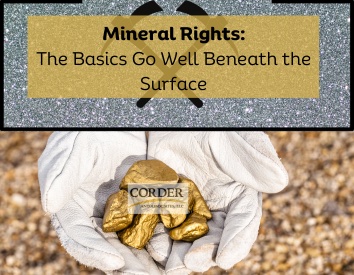Purchasing land in Montana is more complex than a spot in the mountains. For instance, one must consider water rights, mineral rights, covenants, and restrictions, whether it has any other deed restrictions, easements, and more. Having an experienced REALTOR® on your team is a responsible and smart decision. Mineral rights are one aspect of a transaction that can cause it to come to a screeching halt. Did you know that mineral rights can be separate from actual land ownership? That is to say that a landowner may have rights to the land’s surface, but a different owner may own what’s below the surface. It is, therefore, important to remember that purchasing land does not guarantee rights to the mineral deposits below the surface.
What Constitutes as Mineral Property?
Mineral property includes hydrocarbons (oil, gas, and coal), hard rock minerals (gold, silver, copper, and other metals), and other types such as talc, bentonite, uranium, and more. When there is a conflict of ownership, mineral records are complex and require extensive research. Minerals are real property and thus similar to real estate.
Types of Mineral Property
There are several different types of mineral property. It’s important that a mineral owner knows the type of property he or she owns. The simplest way to think about mineral property is that it is owned along with the surface by the same person. The mineral and surface rights are held together and identified as unified tenure. The next type would then be if the surface property’s owner differed from the mineral property’s owner, and it is called a split estate. Sometimes, an owner decides to sell the mineral property or split the surface and mineral interest between the family. Another type is called fractional ownership. An owner owns X percent of the mineral property. Fractionalization often occurs when an owner leaves the minerals to children. The last type of mineral property is severed landowner royalties. These ownerships will be recorded as restrictions on the title.
Different Minerals, Different Owners?
It is possible to separate the ownership of different types of minerals. Therefore, it is important to know exactly which one you own.
Own the Land But Not the Minerals?
It is actually more popular than you would think that surface landowners do not own the minerals beneath. That’s when things get tricky. Let’s say the mineral owners want to develop. That may adversely affect the surface owner when equipment comes rolling in to extract their minerals. Surface owners cannot stop the development. What’s more, sometimes, the boundary lines of surface property do not line up with mineral ownership. You can imagine the many different scenarios from such an arrangement. There could be several different mineral owners under one surface owner. Or vice versa.
Dig Deep
Where can you find information on mineral rights and who owns what? A thorough review of documents and the deed to your property is a good place to start. However, a standard title search doesn’t always specify mineral property and ownership. You can decide whether to do the digging or hire someone else to assist. Here are a couple of starting points for you:
- Obtain the legal description for your property. Head on over to the county courthouse to search the property records.
- Once you find the plat book and locate your property, you can look up deeds and their correlating numbers. Sometimes, there are multiple deeds. By carefully reading and reviewing the deeds, you can determine if mineral rights were ever severed or withheld. If they are severed, a separate mineral deed should be referenced.
- Several complications can arise during a search. For example, the land could have been once associated with a railroad grant or established through a homestead claim when mineral ownership was regarded differently.
If your time is limited or you find yourself wanting to rip out your hair during your investigation, there are professionals who can help. You can hire an attorney or a title company to search for you. In addition, landmen are professionals who research mineral titles for a living. Oil and gas companies typically employ them, but there are independent contractors. There’s a handy directory on the Montana Association of Professional Landmen website: http://www.maplweb.org/mapl-directory.html. Be advised, though, that it can be quite costly to have a mineral search done.
How Much Are the Minerals Worth?
The valuation of minerals is just like real estate; it depends on the type and location. One can take the income approach, determine the amount of recoverable minerals, and then multiply that by the expected market price. Take into account the cost of production. There are licensed appraisers who can assess.
This is a broad overview of a very complex and complicated topic. It also varies from state to state. Corder and Associates are at your service should you need assistance in finding land!




